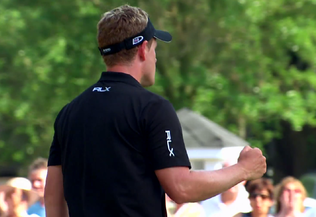 In 2011 Luke Donald achieved something that nobody has ever done before. He was the leading money winner on both the PGA and European Tours in the same year, and to top that off, he also became the world number 1 ranked player. After such an extraordinary year winning both The PGA Player of the Year and The European Golfer of the Year awards no one would argue that it wasn't well deserved. He held the coveted World Golf Ranking number 1 position for 40 straight weeks from May 2011 to March 2012, until Rory McIlroy eclipsed him for a short period, and then they took turns at the number spot over a two month period. By August 2012 Luke had held the number 1 position for a total of 56 weeks. But let's wind the clock back to 1997 for a minute and Luke had accepted an invitation from the Stanford University golf coach to take up a golf scholarship, but the University later withdrew the offer at the last minute. Undaunted by this setback Luke managed to secure a spot at Northwestern University on their golf team where he was to strike up a good working relationship with the Northwestern University golf coach Pat Goss. In 1999 Luke won the NCAA Individual Championship at Hazeltine, and established himself as a world class amateur golfer. He completed an art and music degree at Northwestern and then turned pro in 2001. He managed to get some sponsors invitations in the summer of 2001 on the PGA Tour but wasn't successful in winning enough money in the 6 tournaments he played in to secure his tour card. So he attended the PGA Tour Qualifying School at the end of that year and went on to win his tour card and playing privileges for 2002 season, and was on his way.  Luke maintained his player--coach relationship with Pat Goss and the partnership flourished, and so did Luke's performances, and by 2008 he had cracked the top 30 in the World Golf Rankings. In 2010 he added high performance coach Dave Alred to his team, and Alred's job was to improve the training regime of Donald, which included high intensity practice drills that simulated the type of pressure he faced on the golf course on a daily basis. Unfortunately since then Luke has slipped down the rankings and is currently outside the top 30, with a ranking of 32 and appears to be moving further down. So what has happened to Luke Donald for him to lose his scoring game? At the end of 2012 Alred was given his marching orders, Donald felt he was getting analytic overload from Alred and he wanted to get back to "playing golf" as he described it at the time. Towards the end of the 2013 season, and with his playing performances slipping further, the long term player and coach relationship he had with Pat Goss was also terminated.  Chuck Cook working with Jason Dufner Chuck Cook working with Jason Dufner Donald then initially sought out Sean Foley, Tigers coach at the time, but Foley had no time for a new client and recommended Jason Dufner's coach Chuck Cook. As you will see in my analysis it has not worked up to this point, and he missed out on selection on the European Team for the recently played Ryder Cup. Luke at that time already possessed a world class short game and was an extremely good putter. Although an accurate shot-maker, he thought he was lacking in distance and was wanting to find more "horsepower." The table of statistics below is based over four seasons from 2011 to 2014, and I have separated 2011 and 2012 by describing them as the Pat Goss and Dave Alred years, and 2013 and 2014 years as the Chuck Cook Years for comparison. Hopefully we can identify where Luke may have lost some of his performance edge.  The first thing that stands out for me is Luke's change in swing coach's from Pat Goss to Chuck Cook to gain a few more yards, and improve his strokes gained tee-to-green. Well so far it appears that this hasn't occurred, and in fact the difference between his 2011 and 2014 driving distances is a loss of 5.9 yards! When at your best you're ranked 147, you really cannot afford to be going backwards with tee shot distance let alone anything else. His driving accuracy has also dropped by 1.73% during this period. In looking at it at face value I believe this long game decrease in performance has had quite an effect on his competitive stroke average as well, which has risen by 1.73 shots per round, which translates to nearly 7 shots more per tournament, which I'm sure you'll agree is significant. So apart from his tee shot distance and accuracy, what areas of Luke's game are contributing the most to his slide from the number 1 to his present ranking of 32? Take note of his Par 3, 4 and 5 scoring and ranking in 2011 because it was off the charts compared to his scoring average and par 3, 4 and 5 rankings for 2014. Now look at his approach shots from 50 to 125 yards proximity to hole, 15' 4" and a rank of 2nd in 2011, now compare this to 19' 8" and a ranking of 142 in 2014. That's a difference of 4 feet and 4 inches, and combine this result with his 4.01% drop in putting performance from 15 feet to 25 feet, and there's no doubt that this is where he is leaking some oil. It's the same for his approach shots from 125 to 150 yards, and also his approach shots from 150-175 yards. His proximity to hole with his approach shots is finishing further away from the hole so his ability to convert his putts has suffered. So I'm sure he realizes that his proximity to the hole for this range of approach shots needs to get back to at least his 2011 numbers. 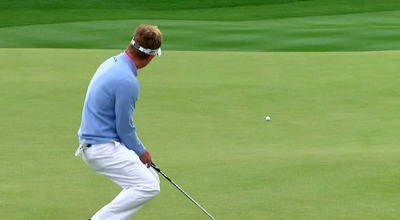 A question that could be asked is whether the swing changes he has made so far with his golf instructor Chuck Cook are partly responsible his drop in performance? It is hard to say at this stage, but there's no question that there is a noticeable drop in his long game performance from his 2011 season to his 2014 season. Only time will tell whether the changes he's making will be the difference he's aiming for. His short putting (under 5 feet and from 5 feet to 10 feet) numbers are extremely good for both periods, and his ranking also confirms that he has maintained his conversion ratio from these important distances. But the 15 feet to 25 feet statistics show a definite decline in performance. Another question to ask is whether he is spending more time on the range working on his swing changes, and possibly neglecting his medium to long distance putting practice? So has Luke stepped over the invisible line of thinking technical swing thoughts to try and generate improvement? We hope not. Luke Donald has a degree in art and music, and you could easily imagine that his ideal learning style or preference would be to learn with strong visual and kinesthetic cues (feels and imagery) rather than with other styles.  So we can be pretty sure that with the expert assistance of his instructor Chuck Cook he will not get caught up in the mine field of analyzing angles and radii, but rather learn how to improve his swing performance in a way that is more congruent with his learning style. We can't be sure either way because we are not privy to the improvement strategies that he and Chuck Cook are working on, but one thing’s for certain, Luke needs to find a way to get to (or close to) the standard of his 2011 season. Right now he’s on a slippery slope that many other exceptional professional golfers have also been on.  We are big fans of Luke Donald and we want to see him get his game back to his 2011 and 2012 performance levels because we never get tired of watching his classical and stylish golf swing in action in tournaments, combined with his ability to craft low scores with his exceptional short game skills. Luke has proven beyond doubt that you don’t need the modern power game to become the number one golfer in the world, and we wish him all the best on his journey back to the top. It's not an easy path, but he's done it before, so he can do it again. David Milne and Lawrie Montague - Pro Tour Golf College Your Success On Tour is Our Business
32 Comments
 On the path to golf score improvement from 80 to 70 you will face many challenges along the way. In our experience most of the challenges you will face will relate to 3 things; 1. Unrealistic Development Timelines 2. Unrealistic Performance Expectations 3. Lack of an Holistic Golf Lesson Skill Development Plan We all want to improve our golf faster, that’s a fact, but this alone can be your biggest obstacle to golf improvement if you don’t manage your golf skill development properly. Golf skill improvement is simply a development process that involves continuously acquiring the right type of information in the form of knowledge and skills (both formally and informally), with the explicit goal of improving your golf skill capability to influence your golf score averages to go lower. We know that ten strokes improvement to some golfers doesn’t seem like much, in the big scheme of things, but it can and does take the majority of golfers many years to learn how to break 80 consistently, and play in the 70's. The question is "what will it take for you to learn how to score in the 70's and more often?" Maybe you already do, but you want to get your scores down into the low 70's, or even the high 60's more often. In this article we will share with you a simple golf lesson development strategy we use at Pro Tour Golf College to help our golfers to lower their scores into the 70’s consistently, and in less time.  Every Golfer Learns in His or Her Own Best Way I’m sure you can think about classes you took in high school that you really enjoyed because you found learning and remembering easier than others? What about the classes that you never enjoyed because you simply didn't get what the teacher was saying, showing you, or getting you to do? Every golfers learning style is as unique as their thumb print, and you need to know your best way of acquiring the knowledge and skills to help you improve your score average. What is Your Preference for Receiving Information?
So you need to understand how you experience information from your environment, through your senses of sight, smell, taste, touch and sound, and then translate the information into something you can understand and eventually do. - A - - B - - C - Golf improvement begins and ends with effective communication Golf improvement begins and ends with effective communication You need to understand your personal access code--your A, B and C's for learning and improving your golf. Another way of saying this is you need to understand your personal golf learning style or preference. When you receive information from your environment (A), your senses are constantly filtering and personalizing the information within your brain (B) so you can make sense of it, and communicate it in your own unique way (C). The more you can interpret the information from your environment and personalize it to suit you, the faster you can learn the information. If you are struggling to improve some aspect of your golf, then take a good look at how the information you are receiving is being presented to you, and determine whether this is the best way for you. Your Way First, Then Their Way This is why it is absolutely essential that you develop a relationship with a golf instructor who has outstanding communication skills, and we don't mean that they can form brilliant and witty sentences, we mean a golf instructor who can personalize his/her golf lessons for you to your unique learning style, so you can more easily bridge the gap from what you currently know, to what you need to know. In this way you can improve your game as quickly as possible, and with a minimum of fuss. Always remember; the communication bridge must be built before you take lessons. Your instructor must understand how your learn best, before you begin to work on skill development. In this way you can be assured that you are going to gain much greater value from your golf lesson experience.  Your Annual Golf Lesson Development Plan Lowering your golf score average from 80 down towards 70 requires very different information from the information that got you from 90 to 80. You need to make sure that your current golf instructor can help you to make the leap to sub 80 scores by providing you with a more specific golf lesson plan for improvement. It’s not enough to just take lessons continually on your full swing and neglect other areas of your game. Scoring consistently in the 70’s requires development of not just your full swing technique, but many other golf skills. Now I know this is obvious, but you would be surprised how many golfers spend most—if not all their time perfecting their full swing technique to the exclusion of everything else. Your golf instructor should above all else be knowledgeable in many areas of golf skill development. They should have a deep knowledge and ability to teach you all the skills that will help you to play in the 70's. In the Pro Tour Golf College program we specialize in getting golfers from 80 to 70, and we do this by focusing on what we call the 6 Golf Skill Development Areas which cover all the types of shots you will play on your journey from the tee to the cup. We believe it’s imperative that your golf instruction program covers the 6 golf skill development areas (not including mental and physical development) to help you to lower your golf scores into the 70’s. So let’s take a look at our model for planning and developing your skills so you can evaluate your current program, and please use our model (with the help of your golf instructor) to improve the golf skills that might be unintentionally overlooked. Golf Skill Lesson Distribution - The 12 Month Lesson Planner How many golf lesson hours do you currently take with your golf instructor over 12 months? My total golf lesson hours working with my golf instructor over the past 12 months is? _____ For example if you take one lesson each week over 45 weeks, that would equate to 45 hours of face to face time with your golf instructor. Now out of the total lesson hours you've calculated that you take in 12 months, approximately how many technique and/or shot-making lesson hours are devoted to the following 6 skill areas?
Why is this important? The quantity of golf lesson hours in your golf skill development program is important because you need enough hours with your instructor over 12 months to work on the variety of skills that you need to develop to help you to play consistently in the 70's. If you are taking a lot of full swing lessons over 12 months, the important question you need to ask is "when will you find the time to have lessons on all the other skills that make up your game?" Your 12 month golf lesson plan should allocate sufficient hours to work on all 6 skills areas as described in our model below. These lessons should be highly specific, and principally focused on developing the weakest of your 6 skill areas into strengths, rather than just enhancing your strongest skills. 6 Golf Skill Development Areas - Golf Lesson Model Your golf lessons should always be part of a well thought out annual plan, with the goal of lowering your golf score average over this period, rather than spending too much of your time out of 12 months just perfecting one or two skill areas. The key distinction here is to develop a range of functional skills to lower your golf score average over 12 months, rather than just perfecting the look of your skills, which is very different. Too often the focus of elite golfers is mostly on full swing perfection, which can take up a big chunk of their 12 month development time period. How many golfers do you know that look like tour players on the golf range, but don't score like tour players on the golf course in tournaments? Working on full swing technique is important, but just perfecting your full swing for perfections sake is a waste of your valuable time that could be better spent working on the other skill areas with your instructor. The key is to determine how much time needs to be invested in golf lessons for the 6 areas over a 6 week period with the help of your instructor. Golf Skill Lesson Distribution - 6 Weeks Using our Golf Lesson Model above, work out the amount of golf lessons you are going to take each week within your micro cycle of 7 days. From there work out how many golf lessons you will take in the next 6 week meso cycle, and then work out which skills will be developed with the help of your golf instructor. Total Lesson Hours For the Next 6 Weeks? _____
You may not be able to take a golf lesson in every skill area within your first meso cycle of 6 weeks, but you should plan to have a lesson in every skill area by your second meso cycle. Keep in mind that you can split 1 lesson hour up into 2 x 30 minute skill development sessions, or even 4 x 15 minute sessions like we have shared in the model below.  Remember the real skill of golf is to produce a good score when you are not playing your best. To do this you need to develop a range of effective golf skills that can back you up when things aren't going well for you. The 6 areas of golf development in the lesson model above should be incorporated into your current golf lesson program with the assistance of your golf instructor. By developing a more complete golf lesson development program, you will cover all the golf skills that will help you to get your game down into the 70’s consistently. David and I wish you the best of luck with it. Lawrie Montague and David Milne - Pro Tour Golf College Your Success On Tour is Our Business  When you practice within the time units you have allocated, you will need to measure some important factors that will influence how effective your golf practice effort will be. A major key to effective golf practice time management is to know how long it takes you to hit a set of golf shots. At Pro Tour Golf College our students develop their golf skills around pre-planned sets of golf stroke repetitions, and these golf strokes could be either shots to a target/s, or sets of 10 practice drill strokes. Golf Practice Habit Number 4 – Managing Strokes and Shots We think of golf repetitions as either shots to a target, or strokes performed when doing drills, with or without the assistance of a training aid. So what is the best way to manage your stroke volume? Consider that stroke volume relates to mainly two important parts:
Do you know? This is an important question, and to answer it correctly you first of all need to determine how long it takes you to hit one set of 10 shots with a full pre-shot routine, to targets on the range, and also to make 10 practice drill strokes without a target. Completing a simple set time check for all the golf skills you practice using a stop watch or timer on your phone will help you to manage the time you need for the most important skills to practice. 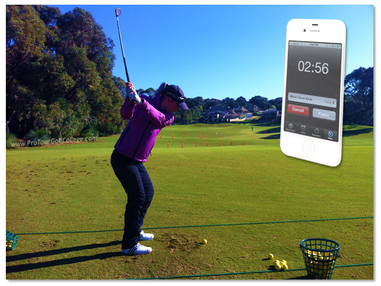 Time sets of 10 shots to find out how long it takes Time sets of 10 shots to find out how long it takes Once you know how long it takes to hit 10 shots with a pre-shot routine and also without, you can easily work out how many stroke repetitions you can perform inside a 15 or 30 minute time window. This is how you manage your stroke volume from day to day, and it represents the amount of strokes you perform per unit of time. You can notice that the actual stroke volume will vary depending on whether you are practicing a technical routine or a targeting routine. You should always design your weekly practice planner by determining how many of your practice time units are technical strokes and how many are targeting shots. How Long Will You Practice? The next part of managing stroke volume is working out how long you will practice? The rule of thumb is to practice for as long as you can maintain the highest level of focus possible. If you start to get distracted and you can’t recover from it, then it is advisable to go and do something else. Our suggestion is to build up a high level of tolerance for practicing for longer hours whilst maintaining a high level of focus (see golf practice habit 5 below). We’ve seen many elite level golfers spend 4, 5 or even 6 hours on the practice range where the duration is long but the quality is short. Yes it’s not uncommon to see elite golfers practice for a short while then check messages on their phone, or get involved in discussions with other golfers practicing thus padding out their practice time. Your goal should always be to extract the highest quality of stroke involvement from your investment of time on the golf range.  Golf Practice Habit Number 5 – Build Mental Focus Endurance Your goal should always be to execute sets of 10 strokes with a very high degree of focus on your stroke intention and stroke attention. This is critical, and your stroke intention in this instance relates to the goal or outcome for the shot you are playing or the drill stroke you are performing. The stroke attention part relates to how effectively you can focus on these outcomes to the exclusion of everything else. Each golf shot you hit must be hit with the intention of completing the procedure from walk in to the finish of the stroke to the very best of your ability. The Last Look A good idea is to peak your concentration on each shot by narrowing your focus to a distant target just before you hit your shot. We call this the last look and we teach our students to hit shots after the last look using a simple 1 to 7 scale where you peak your focus and get into the ideal performance state within the 4 to 5 range on the scale and then execute your shot.  Too often we see elite golfers just going through the motions and hitting shot after shot without their attention firmly focused on controlling their level of single-mindedness on each stroke. Here’s the thing you really need to understand; we all know that the objective is to execute each golf stroke to produce a desired outcome, but what is much more important than this (and overlooked), is the quality of your focus from stroke to stroke and shot to shot. This is the big deal in golf practice and nothing you do in practice is more important than this. You primary goal of practice should be to build up a very high level of mental endurance for focusing on executing each stroke without distraction—rather than achieving a perfect ball flight. Let's face it, many golfers can and do produce excellent ball flight outcomes when there’s no pressure on them, but as soon as the pressure barometer increases, many good golfers discover that their shot-making performance decreases. Why? It’s simple; they don’t practice a 'perfect focus strategy' as much as they practice a 'perfect golf stroke technique,' which is not nearly the same thing. Here's the bottom line; you need to isolate each golf ball out of a set and put all your focus into performing the stroke with no distraction whatsoever. Golf Practice Habit Number 6 – Measure Your Practice Effort Your daily practice generates results or outcomes, and being able to measure every bit of work you perform on the practice range is essential if you desire to improve your skills and lower your scores. The truth is that most elite golfers rarely if ever measure their practice effort, and as you can imagine this makes it very hard to determine where your game is, through any stage in your development cycle. There's an old saying that goes "what you can measure you can improve" and no truer words have ever been spoken. Practicing your golf skills without a way of measuring your results on a continual basis really means that you are guessing how much improvement you are making. Measuring your results is easy to do, and with a note book and pen/pencil you can start to track your progress on the practice range which will help you and your instructor to develop effective practice plans for generating ongoing improvement. What Can You Measure When You Practice? Here's a list of 5 simple things you can measure in your practice sessions:
With a daily practice planner like the one above you can measure how many shots you hit within your allotted time and you will know the answer to this question. You will be able to see whether you achieved your objectives for the practice session or not. Planning your practice and then performing it is an important part of every golf practice session because it will help you to effectively evaluate your practice effort so you can stay on top of your golf development.  Golf Practice Habit Number 7 – Benchmark Your Golf Practice Skills Practice skill benchmarking is a great habit to develop and it's easy to do. Basically the idea is to compare your current golf practice performances for 1 month against results you wish to achieve in the same skills in 3 months time. For example you can compare your current 3 foot practice putting results (how many putts you make percentage) for all of September against a benchmark for the same skill in November. This monthly benchmark strategy gives you something to aim at over 3 months which will keep your focused on generating continuous improvement in the different skills that make up your game. You can benchmark virtually any golf skill you practice, against the results you want to achieve in the future--or even against the best golfers in the game if you want to. In the image below you can see we have established benchmarks for some of our 'A skills' that we identified in part 1 of our article. These are the weakest but most important golf skills for improving our score average in tournaments. You can see that for the 3, 6 and 10 foot putts we have established a benchmark of 1 percent improvement per month for the 3 months from September to November which may seem conservative to you. Understand that the idea behind this is to make steady progress, and since there are always variables like slope, speed, grain, etc. involved in the final analysis it is reasonable with short putts (within 12 feet) to strive for a small incremental improvement of around 1 percent per month. Typically in our Pro Tour Golf College program we look for student improvement in the short-game and long-game targeting skill practice with improvement of around 2 percent per month. We use a number of different improvement strategies and key performance indicators to drive performances upwards, and with the long game we establish specific target diameters at different distances. e.g. Driver tee shot carry - 210 - 220 yards = 24 yard target diameter In the driver example below we have established a target diameter of 24 yards wide for the tee-shot landing area and after 3 months if our golfer improves their tee-shot effectiveness based on the benchmarks established, we will narrow the target down to 22 yards for the next 3 months, and design a new set of benchmarks for him to aim. 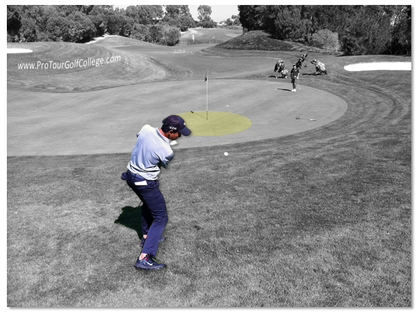 How many can you get into the target zone? How many can you get into the target zone? You can see that the long irons benchmark above (3 and 4 iron) is a target diameter of 18 yards wide. What this means is that our golfer has a target diameter of 18 yards to assess their accuracy with their 4 iron at 185 yards and their 3 iron at 195 yards. We have established this target diameter with a hit / miss tolerance of just 5 yards, which means that each golf shot they hit (in each set of 10 shots) must land within 5 yards of the distance to be counted. With our greenside skills practice we establish target zones for the different shots such as chip, pitch, flop and bunker shots. For ever set of 10 shots you hit to your target you measure and record how many are going into your target zone and like the other practice skills you benchmark your performance for a slight improvement each month to keep you on track for continuous improvement. e.g. Flop shot - 15 to 25 yards = 7 feet target zone (Diameter) Golf practice benchmarking challenges you to examine and also understand where your current golf skill standard is with the different shots that you practice from week to week, and month to month, and this gives you performance targets to continually aim and drive your game towards.  Thanks for Reading and The Best of Luck Well there you have it, 7 essential golf practice habits that when you apply them consistently and thoughtfully, you are guaranteed to drive your performances upwards, and your golf scores downwards. You must get into the habit of tracking, testing and measuring all your golf practice effort for every shot you play on the practice ground if you have any hope of becoming the player you wish to become. Look, the bottom line is that most golfers reading this article won't change the way they practice. However if you are someone who is looking for a competitive edge against the golfers you compete with in tournaments, then do yourself a big favor and implement this super simple process today. With a steady stream of results generated from your practice effort you can adjust, and implement specific strategies (with the help of your golf instructor) aimed at moving your performances ever closer to where you need them to be to become the golfer you truly wish to become. Lawrie Montague and David Milne - Pro Tour Golf College Your Success On Tour is Our Business  Why do you practice, and what is the purpose behind it? And how do you know if you are practicing correctly? These are great questions you need to ask yourself because they will help you to understand how your current golf practice effort drives your golf performance. If you are like many golfers we’ve asked, you practice because you want to improve some aspect of your golf performance. The purpose for many is to improve golf skills so that you can perform them competently on the golf course. This is logical and the way most golfers think about golf practice. At Pro Tour Golf College we believe that golf practice should do more than develop your golf skills to a higher level of competency. We believe that the process of golf practice should literally transform you into a more effective competitor on the golf course. What this means is that the process of practice should above everything else raise your confidence level to hit your golf shots more proficiently when you perceive increased pressure on the golf course in tournament conditions. But how do you do that? How do you practice so the net effect is better shots when you really need them? In today's article (part 1) we’ll take you through the first 3 habits of the ideal practice process for generating improvement in your game. We will introduce you to simple and easy to learn and do golf practice habits that will transform the way you practice, so that you can perform your golf skills more effectively when it really matters.  Make a list of all the golf skills that you need to practice Make a list of all the golf skills that you need to practice Golf Practice Habit Number 1 – The Golf Skill Inventory Before you begin to practice your golf skills you need to decide what golf skills you will work on the most. You also need to decide how these chosen golf skills will elevate your performances on the golf course. How many golf skills do you need to practice each week to play more competitively on the golf course? Good question right? Don’t fall into the habit of just practicing the golf skills you are good at, first identify all the golf skills that need to be practiced, and from there classify the key golf skills that need to be developed and improved the most. Start by making a list of all the golf skills that you need to practice on a note pad like the example above. Your list should describe all the long game and short game skills, and also include trouble shots (whether greenside, or off the fairway). These are the golf skills that will help you to produce competitive scores on the course. After all, isn’t the real reason you practice your golf skills to improve your overall performance on the golf course in tournaments? If it’s not, then you need to look a little closer at why you practice the way you do.  Rank your skills by importance and competency A B or C Rank your skills by importance and competency A B or C Golf Practice Habit Number 2 – The 80/20 Skill Rank The golf score average you are producing currently is the sum total of your level of competency for all the different skills that influence your score. Assess and rank the weakest golf skills out of your list that would have the most positive affect on your performances on the golf course. The simplest way to rank your golf skills is using the A, B and C ranking system, where you rank your skills by level of importance and level of competency. Many different skills make up your game as you can see, but some skills are more influential than others at helping you to score lower. Ranking the golf skills that have the biggest influence on lowering your scores using the simple A, B or C ranking system will help you to stay on top of your skill development. A, B and C Skills Which skills are your ‘A’ skills currently? Your ‘A’ skills are your most important golf skills for lowering your golf score. Your ‘B’ skills are not as important and you are competent at executing them and they come next. This is followed by your ‘C’ skills which are skills you can play competently and rarely play. Now all your skills need to be practiced of course, however over the course of a month your ‘A’ skills which are the 20 percent of golf skills that would make up 80 percent of your score get the most attention. Once you have identified your current ‘A’ skills, you will need to determine what level of competency you are currently at with them. Your level of competency basically describes how capable you are at producing a particular type of shot when you have to in tournaments. Using a simple scale like the one above you can determine your current level of capability -- in this case its tee-shot capability over 6 rounds in tournaments (40 percent success at hitting the fairway) to rate your level of competency. If you rank a flop shot as an ‘A’ skill and you were confronted with a 20 metre flop shot from a tight lie, with a carry of 70 percent to a tight pin position just 2 metres on the green, and a hard and fast green surface, how would you do? Would you be able to play that shot better than 50 percent of the time to within 7 feet (2.5 metres) of the pin? Or how about a slightly downhill 25 metre bunker shot with a steep 2 metre wall facing you where you can just see the top of the pin. How competent would you be with a shot like this? Could you get the ball to within 3 metres of the pin better than 50 percent of the time? You are confronted by many different types of shots during a round, so you must make sure that you are working mostly on your current ‘A’ skills that can help you to keep your score in control. Your ‘A’ skills are your priority golf skills, followed by your ‘B’ skills and then your ‘C’ skills. Golf Practice Habit Number 3 – The Practice Unit Once you have identified your ‘A’ skills and your ‘B’ and possibly your ‘C’ skills you will need to draw up a weekly practice calendar (see below) to manage your golf skill development. You start by determining how many hours you can devote to practicing your golf skills in a week. 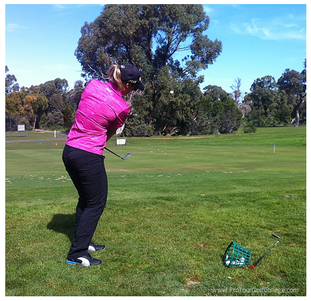 Work on your A1 skills first, then A2 and A3 skills Work on your A1 skills first, then A2 and A3 skills Let’s for example say that you can devote 40 hours per week to practicing your golf skills (including play on the golf course), if you spend 20 hours on the golf course, you have 20 hours left for skill development--your ‘A’ skills will take up around 14 hours or 80 percent of your development time, and your ‘B’ and ‘C’ skills will take about 6 hours. So how do you work out which ‘A’ skills get more of the 14 hours of skill practice and which get less? Rank your ‘A’ skills as A1, A2 and A3. What this is doing is really drilling down into your golf skills to get to the core ‘A’ skills that need more hours of development. Some of the ‘A’ skills will need more technical practice and some will need more targeting practice. This means that you will need to coordinate time within your calendar to spend time with your golf instructor/coach to work on the changes required to raise you level of competence. The easiest way to manage the time aspect of skills development is to work in 30 minute time blocks or units. Basically you allocate the amount of blocks of time you need for each skill. Using the example in our practice calendar above, about 20 hours of skill practice becomes 40 - 30 minute development units. Chunking some of your practice hours into 30 minute practice units makes it a lot easier to allocate sufficient time to the skills that need the most attention. You can see in our calendar that most of the practice hours are split into 2 30 minute practice units.  Next week we’ll continue with our series on the 7 Essential Golf Practice Habits with habits 4 to 7. We will show you how to design the 30 minute golf practice unit, and how you can get really specific with what and how to practice your golf skills within your allocated practice time each week. So see you next week, and have a great week in golf. Lawrie Montague and David Milne - Pro Tour Golf College Your Success On Tour is Our Business  Adam Scott Has Been a Successful Tournament Professional for Over 10 Years Adam Scott Has Been a Successful Tournament Professional for Over 10 Years It’s that time of the year again when ambitious male and female golfers start planning to go to a tour school in an attempt to earn playing rights to play on a professional golf tour. They want to live their dream of becoming a highly paid professional golfer like Adam Scott, earning their income playing in professional golf tournaments. The fields at tour school are an interesting mix of amateur golfers and professionals ranging in age from 18 to 50 from all over the world, all with the same big goal in mind. They want to earn the right to play on a professional golf tour. It is always inspiring to see motivated and serious golfers wanting to achieve their big aim in life playing golf successfully on a pro tour, because many of them have grown up watching their golf stars on TV hitting winning shots to win the big cheques, and achieve a level of golfing glory, and they want some of the same. In today’s article we will explore the important question “how do you know if you are a good enough golfer to go to tour school?” We hope that by the end of our article you will have a clearer idea about whether you are really ready to compete on tour, or that possibly you need to work at your game for a little longer to get ready. Now as I’m sure you already know, all tour schools operate in a similar way in that they publish dates on their website for the stages of their tour school, which is usually from 2 to 4 stages. Each stage is usually 4 rounds of golf and the amateur or professional golfer who has entered tour school will play the first stage of tour school at a golf course/s chosen by the respective tour, and hopefully they will play well enough to continue on to stage 2.  For example at the European Tour School they have three stages, with the first and second stages being 4 rounds each, and the final stage 6 rounds. At most tour schools you will have to compete over at least two stages, or 8 rounds of golf to get to the final stage, and you will have to play to a very high standard to earn your card. And keep in mind just getting a tour card isn't really enough, as in most cases you will need to finish high enough in the final standings to gain entry into most of the tour events. To enter tour school you will also need an official handicap of around scratch (0) to enter most tour schools, although you can enter the Australasian Tour School with a handicap of 2.5, however we suggest that if you don’t have a true scratch handicap or better, then keep practicing because you won't be good enough to get through the qualifying stages. So How Good Do You Really Have to Be? How good do you have to be to really have a good chance of earning your tour card? It's the only question that you need to truly consider and quite honestly unless you have a competitive score average of par or better in national ranked tournaments over a whole season playing at least 50 rounds of golf, you are best to keep working at your game. The simple fact is that every tour school is geared to this minimum standard of excellence.  Think about this for a moment, you will play a minimum of eight rounds to qualify for a small tour like the Australasian Tour, and as many as 17 rounds to qualify for a major tour like the Web.com Tour, and you will be required to play to much better than par in all kinds of weather conditions on the bigger tours to secure your card. The majority of players entering tour schools are not nearly at this standard, and the results show in the final analysis every year. Yes many of these tour hopefuls can score well around their home course, and maybe even around the local courses in their district, but tour school is a different animal altogether. At the 2013 Web.Com Tour School final stage Zach Fischer finished 31 under par for 6 rounds, (averaging 5.1 under par per round) and won the tour school earning his card to play on the Web.Com Tour in 2014 which was a phenomenal effort. Now you would think with that standard of play he would do really well on the Web.Com Tour but as of the end of August 2014 he had earned just US $65,000 dollars, ranking him 77th on the money list, (from the 18 events he had competed in) and he made the cut in 11 events and missed the cut in 7 (61 percent). His score average (actual) at the end of August 2014 was 70.68 ranking him 87th in this category. So it just goes to show that even qualifying for the Web.Com tour in spectacular fashion doesn’t guarantee you anything, as you still have to play to a very high standard every day you compete, if you want to learn how to become a successful tournament professional. To give you an idea of just how good you have to be, to earn last card at the Web.Com Tour School in 2013, you needed to finish at 16 under par for the final 6 rounds, which is averaging 2.6 under par each day. This is after successfully qualifying through the first 3 stages.  4 Tour School Tactics So how do you develop you game to a high enough standard that you give yourself the very best chance of playing on a pro tour, and more importantly, to develop your game to a level where you can stay on tour for years to come? Here are our 4 tour school tips for any serious amateur or professional golfer considering developing their game with the sole purpose of competing at a tour school, and winning a card to play on a professional golf tour. Tour School Tactic 1. Score Average is the Big Deal Understand that your competitive score average over at least one full season (and a minimum of 50 rounds) in national and international ranked tournaments (amateur or pro events) is the only real barometer of whether your standard is good enough to go to tour school. Playing to par or better in local club events, and district tournaments, is just not going to be nearly good enough for a serious crack at tour school; you need to compete and consistently contend in major amateur tournaments to be sure. Don’t be misled by well-meaning family and friends who tell you that because you hit the ball like a top tour player, and you play great on your home courses that it is your guarantee of success at tour school. Over the years many home town hero's have gone to tour school and come home with their tail between their legs. Let me say it again, your long-term competitive score average playing hundreds of holes at lots of different golf course venues, on different golf course styles, in all kinds of conditions, and to a very high standard, is all that matters. Tour school and tour golf will always be about how well you can score over hundreds of holes, and it's not about anything else.  Do You Get Frustrated or Angry Easily? Do You Get Frustrated or Angry Easily? Tour School Tactic 2. It's Not About Mental Toughness You don’t just need ‘Mental Toughness’ to succeed in qualifying and playing successfully on a pro tour, what you really need is The Mental Toughness Endurance Factor, which is not exactly the same thing. Any golfer can be mentally tough enough to play decently for a round or two, but the true test of whether you can make it on a pro tour is going to get down to your emotional endurance and grit over hundreds of holes. Emotional endurance describes your ability to completely maintain and manage your emotional state to no more than a slightly frustrated level in every type of condition imaginable, over hundreds of holes. How many holes can you play when things are not going the way you want before you get frustrated and angry? Can you play at least 90 holes of competitive golf without letting poor performances derail your scoring ability? Emotional endurance is the key tour player factor that helps you to keep your score around par over long periods of time, and many miles of golf course traveled. The Sprint Golfer and The Ultra Marathon Golfer At Pro Tour Golf College we describe to our students the crucial difference between what we call a sprint golfer, and what we call an ultra-marathon golfer. Sprint golfers are good for 18 holes—maybe 36 holes, and then they run out of gas. The true tournament golfer however is someone who can play to a very high standard over 72 holes or more, week-in-and-week-out without suffering from depression or anxiety because of a run of poor play. In our experience you have to be an ultra-marathon golfer than a sprint golfer, and your goal should be to train to become an ultra-marathon golfer if you want to succeed as a professional tour golfer. 18 holes of golf is a walk of roughly 7100 yards from the men's tee's which equates to about 4 miles, or 6.4 kilometers of walking. Now how many rounds of golf, and miles of golf holes do you need to walk to become a top tour golfer? Hundreds of miles is the only answer that makes sense, and what this essentially means is that you must learn how to manage and maintain a low golf score average over hundreds of miles of golf holes. I’m sure that you can see that your emotional endurance combined with well-developed golf skills specifically developed for playing golf on tour is going to be essential for your success?  How Good Would You Be in This Situation? How Good Would You Be in This Situation? Tour School Tactic 3. Develop Your 'Tour Skills' to Tour Grade Tour golf skills are the golf skills you will rely on when your tee to green long game is going a little haywire. Tour golfer’s average around 12 greens per round in regulation, from round to round, which means that on their good days they miss about 4 greens in regulation, and on their bad days they miss 8. Believe me when I tell you that you will have more bad tee to green days than good ones. The tour skills you need to develop to what we call tour grade, and they will be the high and soft flop shots, and a variety of spinning and releasing pitch shots, as well as bunker shots from all types of lies to access tight pin placements which are the norm on a pro tour. And you will also need to be able to accomplish this in wet and dry conditions, and from all types of surfaces and lies. You will also need to be proficient with your recovery techniques from the different types of grasses surrounding the greens. On top of this you will also need to be a fearless putter on severely sloping and fast greens, and have the nerve to keep holing the tough putts inside 5 feet, from hole to hole, and from round to round. Have you noticed when you watch tour events on TV how good the scrambling skills of top tour golfers are, and how this ability helps keep them in contention? You will see the tour skills they rely on that keep them on top of their score management from round to round, and you need to be constantly working and developing your tour skills to tour grade to help you keep your score average down around par or better to have any chance of making it through tour school. Tour School Tactic 4. Finally you will need to be a full time golfer to consider going to tour school. This means that playing golf is your full time job, and playing, practicing and developing your golf skills is what you do for a minimum of 5 to 6 hours per day, for 5 to 6 days per week. Tour school is not for part-time golfers, or for those who "just want to give it a try to see if they’re good enough." Before you go to a tour school you will have invested literally thousands of hours into your game, and you will have earned the special level of confidence that you need, to know that you have made the right choice in your life.  Going to tour school is serious business for serious golfers, and will require your highest standards of excellence for you to have any chance of obtaining your card. So if you believe with all your heart and mind that you have what it takes to go to tour school, and you have maintained a par or better average in important tournaments for a season or more, then you just might have a chance of winning playing privileges to play on a professional golf tour. And live your dream. We wish you the very best. Lawrie Montague and David Milne - Pro Tour Golf College Your Success On Tour is Our Business |
Archives
June 2019
|
Proudly Supported By
Copyright © 2011 - 2018 Pro Tour Golf College
Website Managed By Golf Performance Media
All Rights Reserved
Website Managed By Golf Performance Media
All Rights Reserved










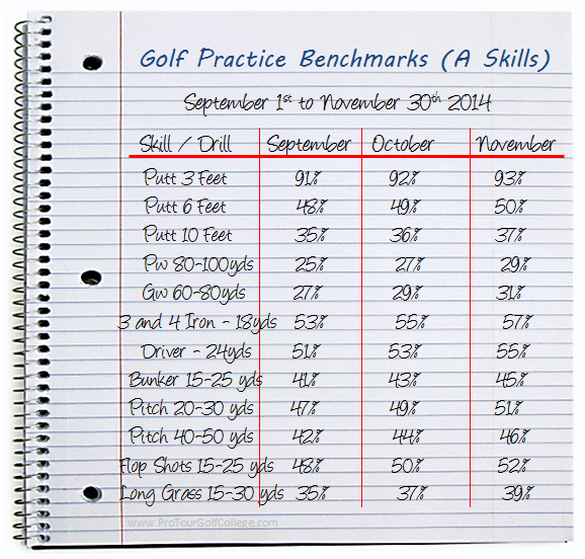


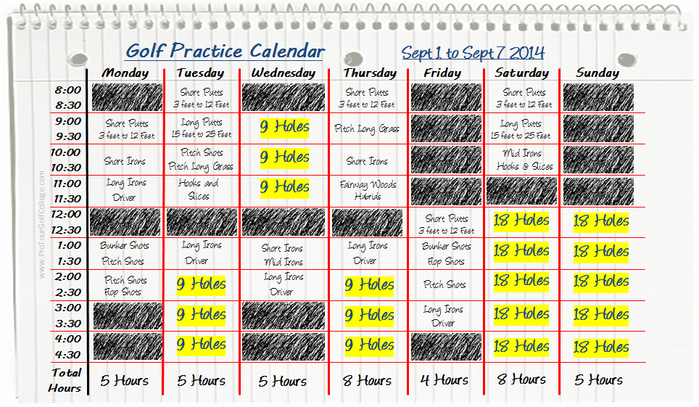


 RSS Feed
RSS Feed



